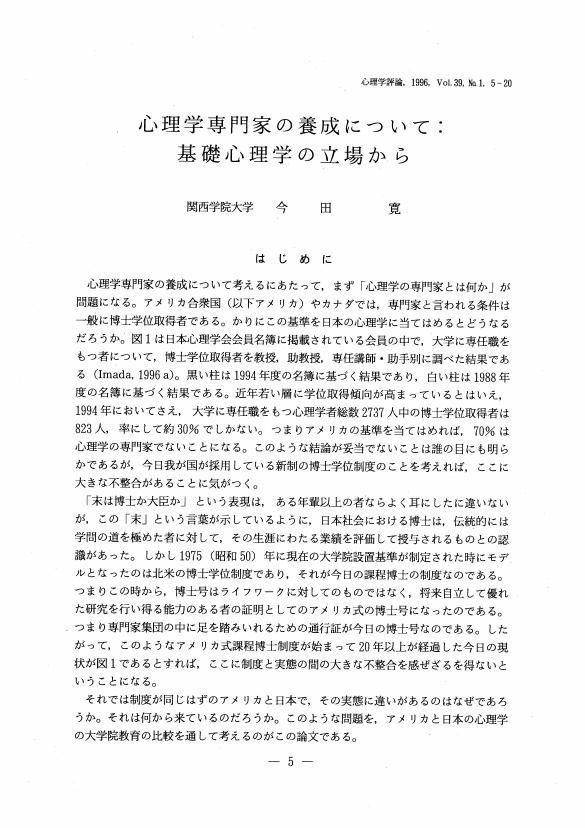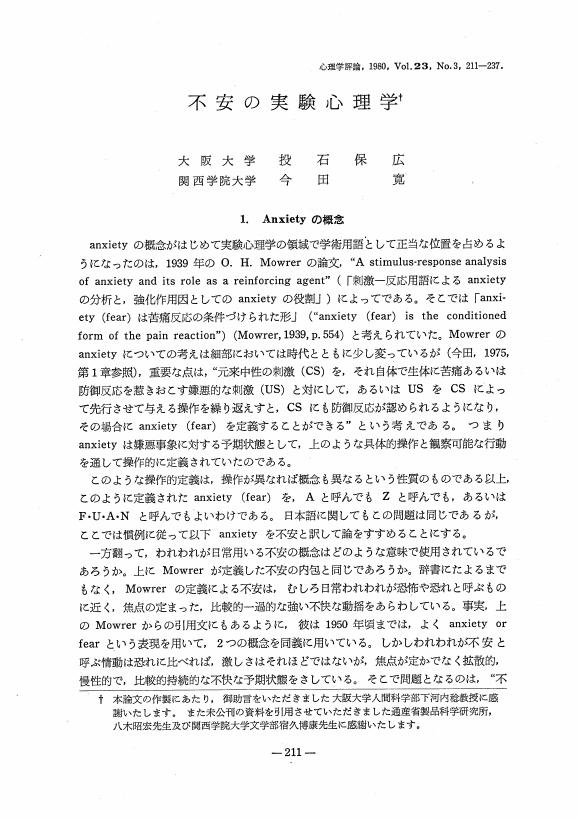18 0 0 0 OA わが国心理学界への行動主義の受容 ――今田恵と関西学院大学心理学研究室を中心に――
- 著者
- 今田 寛
- 出版者
- 心理学評論刊行会
- 雑誌
- 心理学評論 (ISSN:03861058)
- 巻号頁・発行日
- vol.44, no.4, pp.433-440, 2001 (Released:2019-04-12)
12 0 0 0 OA メールインタビュー:今田寛先生に聞く
7 0 0 0 OA メールインタビュー:今田寛先生に聞く
- 著者
- 今田 寛 澤 幸祐
- 出版者
- THE JAPANESE SOCIETY FOR ANIMAL PSYCHOLOGY
- 雑誌
- 動物心理学研究 (ISSN:09168419)
- 巻号頁・発行日
- vol.64, no.2, pp.55-61, 2014 (Released:2014-12-22)
- 参考文献数
- 7
2 0 0 0 OA 人間は「無関係」という関係を学習できるか
- 著者
- 北口 勝也 今田 寛 Katsuya Kitaguchi Hiroshi Imada
- 雑誌
- 人文論究 (ISSN:02866773)
- 巻号頁・発行日
- vol.47, no.4, pp.79-98, 1998-02-20
1 0 0 0 OA 心理学専門家の養成について:基礎心理学の立場から
- 著者
- 今田 寛
- 出版者
- 心理学評論刊行会
- 雑誌
- 心理学評論 (ISSN:03861058)
- 巻号頁・発行日
- vol.39, no.1, pp.5-20, 1996 (Released:2019-07-06)
1 0 0 0 OA 不安の実験心理学
- 著者
- 投石 保広 今田 寛
- 出版者
- 心理学評論刊行会
- 雑誌
- 心理学評論 (ISSN:03861058)
- 巻号頁・発行日
- vol.23, no.3, pp.211-237, 1980 (Released:2019-08-07)
1 0 0 0 OA 生理心理学,情動の心理学研究の近年の‘姿’を探る
- 著者
- 今田 寛
- 出版者
- 日本感情心理学会
- 雑誌
- エモーション・スタディーズ (ISSN:21897425)
- 巻号頁・発行日
- vol.8, no.1, pp.105-117, 2022-12-30 (Released:2023-02-28)
This article is based on the special lecture presented at the joint meeting of the 40th and the 30th annual conventions of the Japanese Society for Physiological Psychology and Psychophysiology and the Japan Society for Research on Emotions, respectively, held at Kwansei Gakuin University on May 28, 2022. In the first half, recent research trends of psychology of emotion were reviewed based on the handbooks of emotion, edited first by M. Lewis and J. M. Haviland in 1993 and followed by its three revised editions in 2000, 2008, and 2016.The psychology of emotion was recognized as an independent research area during 1980s, which developed rapidly during 1990s and into the interdisciplinary affective science in the 21st century. In the second half, recent research trends of physiological psychology were reviewed based on the handbooks on psychophysiology edited by Cacioppo and his colleagues first in 1990 and later revised in 2000, 2007, and 2017. Physiological psychology, born around 1960, showed dramatic changes especially during 1990s called “the decade of the brain,” and developed into interdisciplinary behavioral neuroscience in the 21st century assisted by the development of new technologies. Among the research areas having shown dramatic growth is the affective neuroscience, which proves the significance of this joint convention.
- 著者
- 平 賢一 今田 寛人 松島 安幸 隅田 昌之
- 出版者
- 広島県臨床工学技士会
- 雑誌
- 一般社団法人広島県臨床工学技士会会誌 (ISSN:24358592)
- 巻号頁・発行日
- pp.22-26, 2020
1 0 0 0 OA 異常行動(PBD)研究会の経緯と活動状況
- 著者
- 今田 寛
- 出版者
- 心理学評論刊行会
- 雑誌
- 心理学評論 (ISSN:03861058)
- 巻号頁・発行日
- vol.15, no.2, pp.261-263, 1972 (Released:2019-09-19)
1 0 0 0 OA Hans Jurgen Eysenck:人とその業績(<特集>H.J.アイゼンク)
- 著者
- 今田 寛
- 出版者
- 一般社団法人 日本認知・行動療法学会
- 雑誌
- 行動療法研究 (ISSN:09106529)
- 巻号頁・発行日
- vol.Special, pp.23-36, 1988-03-31 (Released:2019-04-06)
- 著者
- 今田 寛
- 出版者
- 一般社団法人日本認知・行動療法学会
- 雑誌
- 行動療法研究 (ISSN:09106529)
- 巻号頁・発行日
- pp.23-36, 1988-03-31
1 0 0 0 OA ソーンダイクの問題箱実験再分析 : ネコの場合
- 著者
- 今田 純雄 今田 寛 Sumio Imada Hiroshi Imada
- 雑誌
- 人文論究 (ISSN:02866773)
- 巻号頁・発行日
- vol.31, no.1/2, pp.99-122, 1981-12-10
1 0 0 0 OA 消去された恐怖反応の文脈変化による再出現 -ラットの条件性摂水抑制事態での検討-
- 著者
- 玉井 紀子 中島 定彦 北口 勝也 今田 寛
- 出版者
- 公益社団法人 日本心理学会
- 雑誌
- 心理学研究 (ISSN:00215236)
- 巻号頁・発行日
- vol.71, no.6, pp.493-497, 2001-02-25 (Released:2010-07-16)
- 参考文献数
- 26
- 被引用文献数
- 3 4
Renewal of conditioned fear by changing contexts after extinction was explored in an experiment with rats' lick suppression preparation. After repeated pairing of a tone with an electric shock in one chamber (Context A), conditioned fear to the tone was extinguished in the other chamber (Context B) on the water licking baseline. Return to the original chamber renewed the conditioned fear (ABA renewal effect). It was also found that shifting to Context B after both conditioning and extinction in Context A resulted in a brief recovery of the conditioned fear (AAB renewal effect). Implications for relapse of phobia after behavioral therapeutic treatments, such as flooding and systematic desensitization, were discussed.






